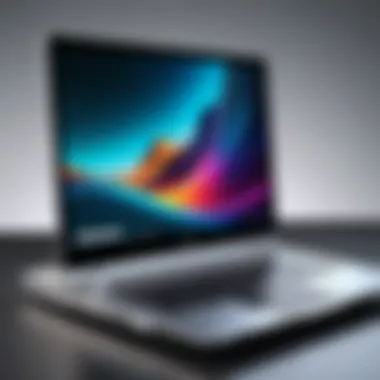Laptop with Swivel Screen: Features and Insights


Intro
As technology progresses, the tools we use daily must adapt to enhance our productivity. Among these tools, laptops with swivel screens have gained popularity, particularly among information technology professionals. These devices not only offer versatility but also cater to a range of use cases that traditional laptops may not accommodate. Understanding the unique features, benefits, and potential drawbacks of swivel screen laptops is essential for making informed decisions in a rapidly evolving tech landscape.
Features Overview
Laptops with swivel screens come with a variety of features designed to meet the demands of modern users. The design elements are particularly noteworthy, as they allow users to easily transition between modes. This adaptability positions swivel screen laptops as invaluable assets for professionals who often engage in collaborative tasks or presentations.
Key Specifications
Laptops with swivel screens typically include:
- Display Quality: High-resolution screens ranging from Full HD to 4K, ensuring crisp visuals.
- Processor and RAM: Powerful processors, often Intel Core i5 or i7, combined with at least 8 GB of RAM to handle multitasking efficiently.
- Battery Life: Extended battery life suitable for on-the-go professionals.
- Weight and Portability: Lightweight designs that enable easy transport without sacrificing durability.
Unique Selling Points
The distinctive characteristics of swivel screen laptops set them apart from traditional models. Some key selling points include:
- Flexibility: The ability to rotate the screen allows for multiple viewing angles and usage modes, supporting a variety of tasks from typing to presenting.
- Touch Functionality: Many models feature touchscreens, enhancing user interaction and productivity.
- Enhanced Collaboration: Swivel screens facilitate easier sharing of content during meetings or group discussions.
"The future of laptops is designed around flexibility and collaborative use. Swivel screens embody this new paradigm."
Performance Analysis
To assess the effectiveness of swivel screen laptops, it is crucial to evaluate their performance in real-world scenarios. This includes benchmarking tests and practical usage examples to highlight their capabilities.
Benchmarking Results
Benchmark tests reveal how these laptops perform compared to their traditional counterparts. Based on various performance metrics:
- Processing Speed: Swivel screen laptops perform similarly under load, but their versatility often leads to more efficient workflow.
- Graphics Handling: Models equipped with dedicated graphics cards excel in handling graphic-intensive applications, making them suitable for design professionals.
Real-world Scenarios
In practical situations, swivel screen laptops provide advantages that traditional laptops may lack. For instance:
- Presentations: Professionals can easily rotate their screens to share information without needing to reposition the device.
- Remote Work: The adaptability of these devices supports a more fluid work environment, particularly for those working from home.
Foreword to Swivel Screen Laptops
In recent years, the laptop market has seen a significant transformation. One innovation that stands out is the swivel screen laptop. These devices offer a unique blend of functionality and flexibility that has captivated both tech professionals and casual users alike. Understanding the importance of swivel screen laptops is essential for anyone looking to enhance their productivity.
Swivel screen laptops are designed to adapt to various usage scenarios. The screen's ability to rotate provides users with multiple viewing angles, making it easier to collaborate or present content to others. This feature has proved invaluable in environments where sharing information is crucial, such as in meetings or educational sessions. The versatility offered by these laptops allows users to switch between traditional laptop mode and a tablet-like experience, catering to different tasks and preferences.
Benefits of Swivel Screen Laptops
- Enhanced Collaboration: The rotating screen can easily shift to face others, enabling seamless sharing of documents or presentations without the need for additional equipment.
- Multiple Functionality: Users can use these devices as traditional laptops or as portable tablets, giving them the freedom to choose the best format for their needs.
- Space-Saving Design: Many swivel screen laptops are designed to be compact, making them easy to carry and reducing desk clutter.
However, there are considerations to account for when choosing a swivel screen laptop. While these devices offer versatility, they can be slightly heavier and more complex than traditional laptops. Understanding these nuances helps inform better purchasing decisions for those in the tech sector.
Ultimately, the rise of swivel screen laptops reflects a broader trend towards adaptive technology in personal computing. As IT professionals increasingly seek devices that can keep pace with their dynamic work requirements, swivel screen laptops emerge as a compelling solution.
Defining Swivel Screen Technology
Understanding swivel screen technology is crucial for grasping the essence of modern laptops designed for enhanced usability. This technology provides a unique approach to interact with devices, combining flexibility with functionality. Swivel screens allow the display to rotate, providing users with multiple viewing angles. This adaptability can accommodate various scenarios such as presentations, collaborative work, or even casual entertainment. In an increasingly mobile-focused world, such versatility becomes a significant asset for the modern professional.
Mechanics of Swivel Screens


Swivel screens operate through a hinge mechanism that permits the display to pivot. The mechanics involved are vital to the device's overall user experience. Typically, these mechanisms utilize a ball-and-socket or a multi-axis hinge system, allowing for smooth rotation without compromising stability. This design not only supports 180-degree turns but also permits additional angles, catering to user preferences. Additionally, the quality of the track and materials used in construction plays a role in the durability and performance of the swivel action.
Moreover, advancements in swivel technology have led to more robust structures that can withstand repeated rotations. Manufacturers often test these systems rigorously to ensure that they have longevity, which in turn assures consumers of their reliability.
Comparative Analysis with Traditional Laptops
When comparing swivel screen laptops with traditional laptops, several key differences emerge that highlight the advantages and disadvantages of each approach. Traditional laptops offer a more straightforward design, typically focusing on portability and screen size. They come equipped with fixed screens that do not provide the same level of flexibility as their swivel screen counterparts.
- Pros of Swivel Screens:
- Cons of Swivel Screens:
- Enhanced user interaction through multiple viewing angles.
- Improved collaborative capabilities during meetings or discussions.
- Added functionality, particularly for presentations or creative work.
- Potential for mechanical failure over time with heavy use.
- May increase the device's overall weight and bulkiness, which could affect portability compared to slimmer models.
Target Audience for Swivel Screen Laptops
The interest in swivel screen laptops stems largely from their ability to cater to specific user needs. This section delves into two main audiences: tech professionals and those in creative industries. By understanding these target groups, we can better appreciate the benefits and considerations that guide the design and functionality of these innovative devices.
Tech Professionals and Their Needs
Tech professionals often operate in fast-paced environments where multitasking is essential. A swivel screen laptop allows them to interact with different functionalities seamlessly. For example, during coding sessions or software development, the ability to rotate the screen offers a flexible workspace that adapts to various tasks.
Besides, many professionals work in collaborative settings where displaying information is key. The swivel function enables presentations without requiring external projectors or screens. This is particularly useful when sharing ideas and progress with team members or stakeholders. Furthermore, the integrated touchscreen can enhance navigation during important meetings or discussions, making interactions more intuitive.
In addition, mobility plays a big role in how tech professionals choose their devices. A lighter swivel laptop can negate the need for multiple devices, supporting users who need to travel between locations. The ability to fold the screen reduces footprint when working in tight spaces, providing an ideal solution for those who work remotely or on the go.
Creative Industries and Client Presentations
In creative fields, presentation and versatility are primordial. Designers, artists, and other creatives benefit directly from the advantages presented by swivel screen laptops. The device acts not just as a computer, but also as a canvas for showcasing work. For instance, artists can easily switch modes to demonstrate their portfolios to clients without complicated setup processes.
These laptops are especially adept in environments where collaboration is key. The swivel design allows for easy turn-around of the screen, thus encouraging feedback and discussion. This can lead to richer ideation sessions and a more dynamic working atmosphere.
Moreover, video editors and graphic designers often utilize touch interfaces for precision in their work. By leveraging touchscreen capabilities, they can manipulate graphics and timelines more effectively than with traditional methods. The practicality in presentations also enables clear engagement with clients, fostering trust and a positive working relationship.
Key Features of Swivel Screen Laptops
The significance of key features of swivel screen laptops cannot be understated. For IT professionals and tech enthusiasts alike, understanding these features offers insights into how these laptops can elevate productivity and adapt to unique work environments. Swivel screen laptops combine technology and design innovations to serve a diverse range of users effectively. In the following subsections, we will examine the main attributes that distinguish these devices from traditional counterparts.
Rotational Design Benefits
The rotational design of swivel screen laptops provides a unique advantage. Users can easily adjust the screen orientation to fit their needs, whether for presentations, gaming, or multitasking. This feature enhances visibility and can be a game-changer during collaborative projects. The ability to rotate the screen allows multiple individuals to view content without battling for position.
Consider the implications for workplaces or classrooms:
- Facilitates group activities and discussions.
- Expands usability in tight spaces.
- Enhances engagement in presentations.
Moreover, swivel screens often permit precise angles, allowing for comfortable operation across various environments. This aspect can greatly reduce ergonomic strain, making it easier to work for extended periods.
Built-In Touchscreen Capabilities
Touchscreen functionality in swivel screen laptops adds another layer of versatility. It enables direct interaction with the device, making navigation intuitive. This direct manipulation can speed up workflows, particularly for tasks involving design or data presentation.
Some benefits of touchscreen technology include:
- Increased efficiency in accessing applications.
- Enhanced creativity for designers or artists through gesture-based inputs.
- Accessibility options for users with different needs.
The integration of touchscreen capabilities also aligns well with software trends that prioritize touch-based interfaces, further bridging the gap between traditional computing and advanced interactions.


Enhanced Portability and Flexibility
Portability is a key consideration for any laptop user. Swivel screen laptops are designed to be lightweight, improving their accessibility for users on the go. Their compact nature and flexible design make them suitable for various environments, such as cafes, airports, or co-working spaces.
Points to consider regarding their portability include:
- Foldable or adjustable designs allow easy transportation.
- Long battery life complements the on-the-go lifestyle.
- Robust built quality, which ensures durability during travel.
Flexibility further extends to how users can utilize these devices. For instance, switching between studio setups for graphic design work or simple office tasks becomes seamless. This enhanced adaptability caters perfectly to the demands of modern work culture, where versatility and efficiency are crucial.
To summarize, the features presented in swivel screen laptops are tailored for an active user base. Each element contributes to a comprehensive computing experience that transcends traditional limitations. Understanding these functionalities is vital for making informed purchasing decisions and maximizing workplace productivity.
Potential Drawbacks of Swivel Screen Laptops
In the exploration of swivel screen laptops, it is crucial to consider their potential drawbacks. While these devices offer many advantages, they also come with specific challenges that users must assess. The insights on the drawbacks can help IT professionals and tech enthusiasts make informed purchasing decisions. Issues like durability and weight management should not be taken lightly. Assessing these factors can be vital for ensuring a seamless integration of such technology into one's workflow.
Durability Concerns
Durability is a significant factor when evaluating swivel screen laptops. The hinge mechanisms, which allow the screen to rotate, are complex. This means they may be more susceptible to wear and tear. Users often report that after a prolonged period of use, the rotational system can become loose or malfunction.
- Material Quality: The construction materials used can greatly influence the lifespan of the device. Many models opt for lighter materials, which may compromise strength.
- Warranty and Support: Potential buyers should look for laptops that come with robust warranties that cover mechanical failures related to swivel screens. This often indicates the manufacturer has confidence in their durability.
Users need to consider if their work environment might expose the laptop to stress, which could exacerbate these durability issues. Frequent travel, for example, may present a higher risk for damage compared to stationary use.
Weight and Bulkiness Factors
Another drawback of swivel screen laptops is their weight and bulkiness. While many models attempt to maintain an ultra-portable design, the added mechanisms can make them heavier than traditional laptops.
- Portability Issues: For those who prioritize mobility, swivel screen laptops may pose some challenges. Carrying a heavier laptop can lead to discomfort, especially during extended periods, such as in travel or while commuting.
- Valuable Space: The additional bulkiness can also affect how users position their devices. For instance, in tight spaces like on planes or trains, a thicker laptop may be less convenient.
Ultimately, IT professionals must weigh these factors against the benefits offered by swivel screen technology. Assessing how these drawbacks impact personal or professional use is essential.
Use Cases for Swivel Screen Laptops
Understanding the practical applications of swivel screen laptops is crucial for anyone considering their use. These devices offer versatility that extends beyond traditional laptops. The unique design allows for a seamless transition between various modes of use. As technology evolves, so do the environments in which we find ourselves needing to work or present. Swivel screen laptops cater to a diverse range of situations, making them particularly appealing to professionals in multiple fields.
Travel and Remote Work
Swivel screen laptops excel in travel and remote work. The form factor of these laptops ensures that they remain compact and lightweight, which is essential for those who frequently relocate. The ability to rotate the screen is highly beneficial in tight spaces, whether on an airplane or at a crowded café. Engaging with the device becomes easier when one can adjust the screen to fit the surrounding environment.
Moreover, many swivel screen laptops have touch capabilities. This feature allows users to interact directly with applications, making navigation more intuitive during presentations or casual usage while traveling. The combination of portability and functionality makes them a strong choice for remote work, especially for those who need all-day productivity without being tethered to a desk.
Educational Settings and Lectures
In educational settings, swivel screen laptops facilitate interactive learning experiences. Educators can easily share content with students in a more engaging manner. The ability to swivel the screen enables presentations that can be easily viewed by an entire classroom, eliminating the need for large projectors or screens.
Students benefit from these devices as well. The tactile nature of a touchscreen enhances learning through direct interaction. In group projects, the ability to share the screen becomes easier, fostering collaboration among peers. Swivel screen laptops can transform the classroom experience into one that is dynamic and adaptable, suiting various educational methods.
Meetings and Collaborative Projects
Meetings, whether in-person or virtual, benefit significantly from swivel screen laptops. When teams collaborate on projects, the versatility these devices provide is advantageous. Participants can swivel the screen to present materials, documents, or even demonstrations without losing visibility for other attendees.
This flexibility also proves useful in brainstorming sessions. The compact design of swivel screen laptops enables easy movement across a conference room or collaboration space. Users can switch between individual tasks and group discussions seamlessly. Increased productivity comes from the ability to adjust the screen's position according to the needs of the discussion, ensuring everyone remains engaged.
"The ergonomic benefits of swivel screen laptops enhance comfort during long working hours across diverse settings."
In summary, the use cases for swivel screen laptops highlight their adaptability across different contexts. From traveling professionals to educators and collaborators, the advantages these devices offer can enhance productivity and create more engaging interactions. As the market continues to develop, understanding these use cases will help potential buyers make informed decisions.


Market Trends in Laptop Design
In the evolving world of technology, understanding market trends in laptop design is vital. This section emphasizes the growing significance of swivel screen laptops within the broader context of consumer electronics. The demand for devices that offer enhanced functionality and adaptability reflects the needs of modern users, particularly IT professionals and tech enthusiasts. As various manufacturers innovate, the design and features of laptops are becoming more user-centric, incorporating feedback and preferences gathered from the market.
Consumer Preferences and Feedback
Recent surveys and studies have illustrated a shift in consumer preferences towards multifunctional devices. Users are increasingly seeking laptops that can serve multiple purposes, such as gaming, professional work, and content creation. Swivel screen laptops have risen in popularity partly due to their versatility. Feedback suggests that users appreciate the ability to rotate their screens for different applications, such as collaborative work or presentations. They allow for easier sharing of content when in group settings.
- Preferred Features:
- Touchscreen capabilities
- Lightweight and portable designs
- Long battery life
- High-resolution displays
This trend indicates a preference for devices that cater to dynamic work environments and lifestyles. Manufacturers are starting to take these insights seriously, adapting their designs accordingly.
Competitive Offerings in the Industry
With the increasing demand for swivel screen laptops, competition in the industry has intensified. Numerous brands have been entering the market, each offering unique features and specifications. Companies like Dell, HP, and ASUS have released models with innovative swivel mechanisms, positioning themselves as leaders in this niche. Each brand's approach to design highlights different use cases.
- Dell XPS Series: With premium build and high-resolution displays, ideal for creative professionals.
- HP Spectre x360: Known for its stylish design and durable hinge design, caters to both business and leisure users.
- ASUS ZenBook Flip: Focuses on portability and functionality, making it a strong contender for those who travel frequently.
The competition encourages continuous improvement in technology. Manufacturers are not only refining their swivel mechanics but are also enhancing battery life and processing power to meet user demands. This focus on innovation is reshaping the laptop landscape, making it crucial for prospective buyers to stay informed.
"The shift towards swivel screen laptops reflects a broader trend in technology towards functionality and adaptability, catering to the needs of users across multiple sectors."
In summary, the market trends suggest a robust future for swivel screen laptops. The convergence of consumer preferences, competitive offerings, and technological advancements positions these devices as significant tools for productivity and creativity.
Future Developments in Laptop Technology
The significance of future developments in laptop technology is paramount as advancements pave the way for enhanced user experiences and increased efficiency. In the context of swivel screen laptops, these innovations hold the potential to transform not only the design but also how professionals engage with their devices. Understanding these trends can help inform purchasing decisions and better align technology with users' evolving needs.
Innovations in Swivel Mechanisms
The evolution of swivel mechanisms is a crucial aspect of future laptop technology. Manufacturers are increasingly focused on refining these designs to improve durability and functionality. Current innovations may include:
- Magnetic Swivel Hinge: A system that allows for smoother transitions between various positions. This helps reduce wear on the hinge and extends the lifespan of the device.
- Multi-Angle Rotation Capability: Users can benefit from options that offer multiple angles for the screen. Such flexibility can enhance comfort during use, especially for tasks that require different viewing perspectives.
- Self-Locking Mechanisms: This enhancement ensures that the screen stays in place during use, which can be valuable during presentations or multitasking scenarios.
These kinds of advancements not only enhance the ergonomic experience but also cater to the diverse needs of tech-savvy audiences.
Potential for Integration with Augmented Reality
As augmented reality (AR) technology continues to progress, laptops with swivel screens may be at the frontier of integrating these capabilities. This shift can have wide-reaching implications for various industries. The potential applications include:
- Enhanced Collaboration: Those in education and business may find new ways to engage with content. AR combined with swivel screen technology can facilitate more interactive presentations that captivate audiences.
- Immersive Learning Environments: In educational settings, integrating AR may allow students to explore subjects in 3D, making learning more dynamic and interactive. Swivel screens can further this by offering varied angles for viewing.
- Design Visualization: For creative professionals, having a device that supports AR can streamline processes. Designers can visualize projects in real-time, manipulating elements on a swivel screen to better assess design aspects.
These forward-looking integrations promise to elevate the functionality of swivel screen laptops, making them not just tools but also facilitators of innovative experiences.
Finale and Final Insights
In the ever-evolving world of technology, swivel screen laptops offer unique functionalities that set them apart from traditional models. The conclusion of this analysis underscores the significance of understanding both the advantages and potential drawbacks of these devices. For IT professionals, outcomes depend largely on effective tools. The design of swivel screen laptops is not just innovative; it addresses specific user needs by enhancing interactivity, portability, and collaborative features.
Key Takeaways for IT Professionals
IT professionals, in particular, can benefit greatly from swivel screen laptops. Here are several key takeaways:
- Versatility: Swivel screen design allows for various modes of usage. This can be particularly beneficial during team meetings or presentations, enabling easy sharing of the screen without the need to relocate.
- Enhanced Productivity: The ability to switch screen positions quickly helps streamline workflow. For IT professionals who manage multiple tasks, this functionality minimizes disruptions.
- User-Centric Features: Touchscreen capabilities are integrated with the swivel mechanism. This makes it easier to navigate applications, contributing to efficiency.
Each of these points illustrates how adaptive these devices can be, tailored specifically for the needs of IT workers.
Making Informed Purchase Decisions
When considering a swivel screen laptop, several factors should influence purchasing decisions:
- Assess Your Usage Needs: Understand your primary work activities. If frequent presentations or mult-tasking are involved, these laptops may be more adept than standard models.
- Evaluate Durability: Research the build quality. Swivel mechanisms can be prone to wear over time. Checking reviews can offer insights into longevity.
- Check Portability: Consider the weight and size. The balance between flexibility and ease of transport is crucial.
- Budget Considerations: Prices can vary widely. Evaluate features that matter most to you to align with your budget.
Making meticulous evaluations of these factors ensures that you not only choose a device that meets your current requirements but also one that remains relevant amid rapid technological advancements.



